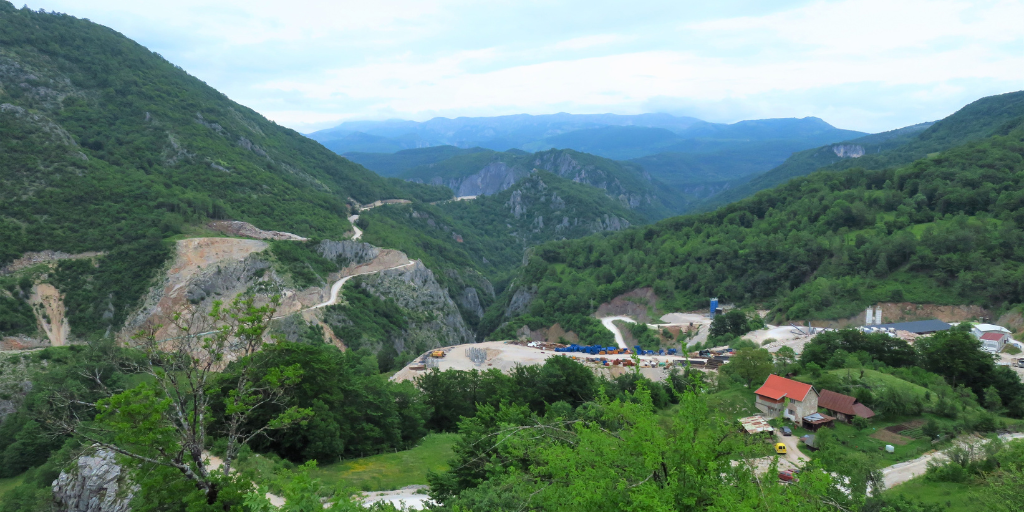A 35 MW hydropower plant was completed in 2024 on a pristine section of the Neretva river at Ulog. Seven more plants are also planned further upstream.

Stay informed
We closely follow international public finance and bring critical updates from the ground.
Key facts
Project promoter: EFT – HE Ulog d.o.o, a subsidiary of the EFT Group (Ulog) and MHE Marvel d.o.o. (HES Gornja Neretva)
Installed capacity: 35 MW
Lead contractor: Sinohydro, China
Financing: Ulog: Reportedly, EFT’s own funds; No information available for Marvel’s plants.
River: Upper Neretva
Protected areas: Gornji tok Neretve Emerald Site
Other key risks: Geological – landslides
Key issues
– The Ulog project was completed in 2024 and seven more plants are planned in an Emerald site.
– The terrain appears unstable – two workers were killed by landslides in 2013.
– People downstream in Konjic fear that earthquakes could cause flooding.
Background
The EFT Group’s 35 MW Ulog plant, with a 53-metre high dam, was built by China’s Sinohydro and completed in 2024. A series of seven smaller plants is also planned further upstream by local company Marvel d.o.o. and would turn most of the upper course of the river – a section of about 38 kilometres – into a series of dams, pipes and reservoirs.
Risky construction
Work on the Ulog plant started for the first time in 2013, but in July that year, two fatal incidents took place and works stopped. On 4 July, a worker from the Prijedorputevi company was killed by a rock breaking off a cliff face while building access roads. Only four days later on 8 July, another worker from the same company was also killed by a rockslide, and another worker taken to hospital. After this, the works were put on hold while more research was done, but in 2017 the project was redesigned with the dam slightly further downstream. It remains to be seen whether the new design will be any safer.
People living downstream fear that the operational phase of the plant will also put them in danger, as the location where the plant is being built is where a landslide in 1934 caused the biggest floods in the history of Konjic. According to local people, the landslide blocked the Neretva, which then burst through, sending a massive wave downstream.
Neretva - one of the most biodiverse rivers in Europe
The projects are also subject to international legal challenges under the Bern Convention and Energy Community Treaty, as the Bosnia and Herzegovina authorities failed to protect the upper Neretva – part of the Convention’s Emerald Network – by permitting hydropower development along its entire length.
Although the environmental impact assessment studies for the Ulog project and the other Upper Neretva hydropower projects identified several significant species such as otters and crayfish being present, the government of the Republika Srpska Entity concluded, without any evidence, that these projects would not have a negative impact on the environment and could be implemented.
In July 2022, the first Neretva Science Week, organised by the Center for Environment together with Riverwatch and Euronatur, identified 1300 species living on the upper Neretva, of which 24 were new for Bosnia and Herzegovina, and eight species were new to science.
High-risk investments
Considering the rich biodiversity downstream above Konjic, including marble trout, the endangered soft-mouthed trout, white-clawed crayfish, kingfishers and endemic invertebrates, the impact on the Federation of BiH is a major concern.
As of October 2025, the other seven plants are not moving ahead significantly.
Latest news
Kambarata hydropower project: greater scrutiny from international banks is needed
Blog entry | 19 December, 2025Kyrgyzstan is promoting the massive 1,860 MW Kambarata-1 Hydropower Plant (HPP) as a solution to its ongoing energy crisis. The project, a joint effort with Uzbekistan and Kazakhstan on Naryn River, is actively seeking funding from international financial institutions like the World Bank, the European Bank for Reconstruction and Development (EBRD) and the European Investment Bank (EIB).
Read moreAlbania’s Skavica dam can’t get off the ground – time to finally cancel it!
Blog entry | 24 November, 2025The highly damaging hydropower project could hardly have had stronger political support at its inception, with the country’s parliament passing a special law in 2021 to appoint U.S. construction giant Bechtel as the main contractor. But four years later, the project has stagnated, with no environmental permit and no financing.
Read moreRomania’s Parliament paves the way for environmental destruction and ‘foreign agent’ repression
Blog entry | 20 October, 2025Romania stands at a dangerous crossroads. Last week, a law initiated by the senator Daniel Zamfir in 2022 and already then rejected by the Senate, passed by a crushing majority (262–33) in the decisive Deputies Chamber.
Read moreRelated publications
Kungrad 1-3 wind power project, Uzbekistan
Policy comments | 11 March, 2025 | Download PDFKungrad is one of several large-scale renewable projects featuring extensive transmission lines slated for remote, wild areas in Central Asia – an alarming practice that hinders the sustainable energy transition.
How to interact with development banks lending to hydropower projects in Central Asia: A toolkit for civil society activists
Toolkit | 3 February, 2025 | Download PDFThis toolkit is aimed primarily at civil society organisations in Central Asia tackling the construction of dams or other unsustainable water infrastructure.
The Upper Horizons complex, Bosnia and Herzegovina
Briefing | 18 December, 2023 | Download PDFThe Upper Horizons hydropower complex has been planned since the mid-20th century, and is planned to consist of three plants — Dabar, Nevesinje and Bileća — linked by a series of tunnels and channels. If completed, it would have a devastating impact on the karst ecosystems of eastern Herzegovina and beyond.
